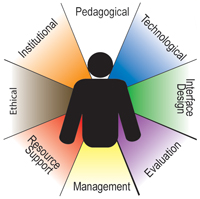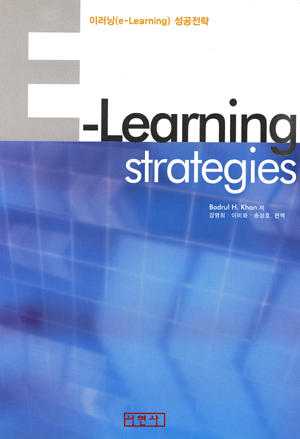

The seeds for the e-Learning Framework
began germinating with the question

Badrul H. Khan




Interested in writing about Web 2.0 and 3.0 in learning? More ...
Second Life
An Instititutional Checklist for Second Life using the E-Learning Framework.
ANNOUNCEMENT
- Khan's books on E-Learning (based on the E-Learning Framework) have been translated into the following languages: Arabic, Chinese, Korean, Thai, Turkish, Portuguese, Italian, Spanish, German, Slovak and Danish. We are currently looking for individuals interested in translating Khan's E-Learning book in Japanese, French, Malay and other languages. If interested, please email us as soon as possible.
- The framework is being used by doctoral students and professional researchers worldwide. If you are interesred in using the E-Learning Framework in your research, please contact us.
- Workshops, seminars and courses based on the Framework are available at McWeadon Education.
About the Framework ...
Badrul Khan describes the dimensions of the e-learning framework
Copyright information:Acknowledgement | Audience | A Complete List of e-Learning Dimensions and Sub-dimensions | PowerPoint Presentation Slides on the Framework | Khan speaking on Enterprise Performance Solution (Video) | Khan serves as a panelist (video) for PEDAGOGY 202 FOR DISTANCE LEARNING: MEASURING WHAT MATTERS. (Video) | Khan's Keynote Presentations on the Framework | One-Page Flyer for the Framework | Comments on the framework by individuals involved in distance learning
May be freely copied or excerpted for educational purposes with credit to the author.
Download Framework Image 400x400 (82.8 KB) | 300x300 (53.9 KB) | 200x200 (27.8 KB)
Download framework images in other languages.
Research Studies, Articles, reports, Interviews, Weblogs, Presentations using the Framework ...
Research Studies using the Framework | Media Interviews | Online Journals - Newspapers articles or reports using the Framework | Books containing chapters on the Framework| Sites Using the Framework | Building Effective Blended Learning Programs Using Khan's Framework by Harvey Singh | Reports using the Framework | Weblogs with reference to articles using the Framework | Framework used by others in their Presentations | Articles citing Badrul Khan. | Framework used as Faculty Development Model. | Plans for Virtual Education or eLearning | OMNI - A Content Development Tool (SCORM & Section 508 Compliant) using the Framework | E-Learning P3 Model People-Process-Product Model | Planning Committee WebCT
Scholar Google Search for the Framework.
Badrul Khan's Recent Books Based on the Framework









Khan's E-LEARNING books in Arabic, Chinese, Korean, Italian, Slovak versions are available now. Other language versions are coming soon!

- Instructors, Teachers, Trainers, Training Managers, Distance Education Specialists, E-Learning Specialists, Virtual Education Specialists, E-Learning Project Managers, Instructional Designers, Corporate Education Specialists, Human Resources Specialists, Performance Technologists, Educational Technology Coordinators, Media Specialist, Webmasters, Writers/Editors and Technical Support Staff can use the framework to plan, design, evaluate and implement e-learning modules, courses and programs.
- Virtual/Corporate University Designers can use the framework to plan, design, evaluate and implement corporate/virtual universities.
- School Administrators, Higher Education Administrators, Department of Education Staff, Ministry of Education Staff, Virtual and Corporate University Administrators, Human Resources Managers and Consultants can use the framework to develop strategic plans for designing, evaluating and implementing e-learning initiatives.
and ...
- Anyone contemplating a career in training and development, curriculum planning, and Internet applications can use the framework to learn about e-learning design strategies.
 When I presented the WBL framework at the Utah State University (USU) in 1997, Professor David Merrill of USU encouraged me by saying he would definitely use the WBL framework for designing Web-based instruction. I really like to thank David Merrill for his encouragement and early endorsement. I would like to thank students at the University of Texas at Brownsville, George Washington University, George Mason University and Towson University who used the WBL framework as part of their coursework to review existing Web-based instruction and training courses. Their comments and suggestions were very useful. I would also like to thank participants in my various keynote and invited addresses for their insightful comments and suggestions about the framework. Finally, I would like to thank the following for their critical review of the framework:
When I presented the WBL framework at the Utah State University (USU) in 1997, Professor David Merrill of USU encouraged me by saying he would definitely use the WBL framework for designing Web-based instruction. I really like to thank David Merrill for his encouragement and early endorsement. I would like to thank students at the University of Texas at Brownsville, George Washington University, George Mason University and Towson University who used the WBL framework as part of their coursework to review existing Web-based instruction and training courses. Their comments and suggestions were very useful. I would also like to thank participants in my various keynote and invited addresses for their insightful comments and suggestions about the framework. Finally, I would like to thank the following for their critical review of the framework:
- Greg Kearsley, consultant, USA
- Betty Collis, University of Twente, Netherlands
- Som Naidu, University of Melbourne, Australia
- Robin Mason, The Open University, England
- Ali Ekrem Ozkul, Anadolu University, Turkey
- Jianwei zhang, Tsinghua University, China
- Brenda Bannan-Ritland, George Mason University
- Myunghee Kang, Ewha Womans University, Korea
- Sanjaya Mishra, Commonwealth Educational Media Centre for Asia, India
- Alex and Lani Romiszowsky, Brazil
- Reynold Macpherson, The University of Auckland, New Zealand
- Herman Van Der Merwe, South Africa
- Jeroen van Merrienboer, Open University of the Netherlands
- Charlotte N. (Lani) Gunawardena, University of New Mexico
- Walter Wager, Florida State University
- Amy Holloway, World Bank
- Thomas Reeves, University of Georgia
- Janette Hill, University of Georgia
- Philip Doughty, Syracuse University
- Nada Dabbagh, George Mason University
- Joanne Williams, University of Texas
- Zane Berge, University of Maryland
- David Peal, consultant, USA.
- Harvi Singh, e-Learning consultant, USA.

|
. © Badrul H. Khan. All rights reserved. May be freely copied or excerpted for educational purposes with credit to the author. Download Framework Image 400x400 (82.8 KB) | 300x300 (53.9 KB) | 200x200 (27.8 KB) | Contact |